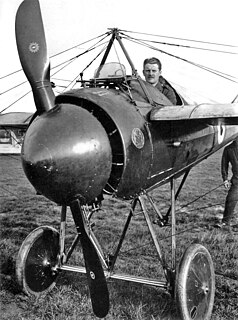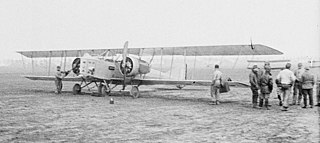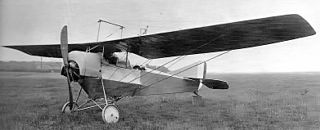| REP Type N | |
|---|---|
 | |
| Role | Reconnaissance aircraft |
| National origin | France |
| Manufacturer | REP |
| First flight | 1912 |
| Primary user | Aéronautique Militaire |
The REP Type N was a military reconnaissance monoplane produced in France in 1914. [1]
| REP Type N | |
|---|---|
 | |
| Role | Reconnaissance aircraft |
| National origin | France |
| Manufacturer | REP |
| First flight | 1912 |
| Primary user | Aéronautique Militaire |
The REP Type N was a military reconnaissance monoplane produced in France in 1914. [1]
It was a wire-braced, mid-wing monoplane of conventional design with fixed, tailskid undercarriage. [2] The fuselage was constructed of steel tube and was of triangular cross-section, with the apex on the ventral side. [2] The pilot and observer sat in tandem, open cockpits. [2] Lateral control was by wing warping. [2]
The type was selected by the Aéronautique Militaire to equip two squadrons, REP 15 and REP 27. [2] Type Ns from the former unit flew reconnaissance missions during the Battle of Charleroi in August 1914, and Type Ns from both units flew missions during the First Battle of the Marne in September. [2] Intelligence provided by reconnaissance aircraft proved a decisive factor in the Allied victory at the Marne. [3] In January 1915, the two units merged and were re-equipped with Caudron G.3s, but continued to operate the REP Type N at least as late as March. [2]
The Type N also formed the backbone of the Ottoman Air Service in 1912, and these machines were used operationally during the First and Second Balkan War in 1912–13. [2] At the outbreak of war, two Ottoman Type Ns were seized while in transit through Serbia, and were put into Serbian military service. [2] They were soon joined by a third machine, captured from the Ottoman forces, but the Serbs seem to have made little use of the type. [2] By October 1914, Ottoman Type Ns were relegated to training duties. [4]
Data from Davilla & Soltan 2002, p.432
General characteristics
Performance
Aircraft of comparable role, configuration, and era

The Bréguet XIV or Bréguet 14 was a French biplane bomber and reconnaissance aircraft of World War I. It was built in very large numbers and production continued for many years after the end of the war.

The Morane-Saulnier N, also known as the Morane-Saulnier Type N, was a French monoplane fighter aircraft of the First World War. Designed and manufactured by Morane-Saulnier, the Type N entered service in April 1915 with the Aéronautique Militaire designated as the MoS-5 C1. It also equipped four squadrons of the Royal Flying Corps, in which it was nicknamed the Bullet, and was operated in limited numbers by the 19th Squadron of the Imperial Russian Air Force.

The Morane-Saulnier L, or Morane-Saulnier Type L, or officially MoS-3, was a French parasol wing one or two-seat scout aeroplane of the First World War. The Type L became one of the first successful fighter aircraft when it was fitted with a single machine gun that fired through the arc of the propeller, which was protected by armoured deflector wedges. Its immediate effectiveness in this role launched an arms race in fighter development, and the Type L was swiftly rendered obsolete. The original Type L used wing warping for lateral control, but a later version designated Type LA was fitted with ailerons.

The Nieuport 10 was a French First World War sesquiplane that filled a wide variety of roles including reconnaissance, fighter and trainer.

The Voisin III was a French World War I two-seat pusher biplane multi-purpose aircraft developed by Voisin in 1914 as a more powerful version of the 1912 Voisin I. It is notable for being the aircraft used for the first successful shooting down of an enemy aircraft on October 5, 1914, and to have been used to equip the first dedicated bomber units, in September 1914.

The Caudron R.4 was a French World War I twin-engine biplane reconnaissance/artillery cooperation aircraft and the progenitor of a series of successful aircraft that filled a variety of roles with the French Aéronautique Militaire.

The Dorand AR.1 was a World War I French two-seat observation biplane aircraft used by the French Air Force, the American Expeditionary Force and, in small numbers, by Serbian Aviation.

The SPAD S.A was a French two-seat tractor biplane first flown in 1915. It was used by France and Russia in the early stages of the First World War in the fighter and reconnaissance roles. It was a unique aircraft that carried its observer in a nacelle ahead of both wing and engine.

The FBA Type H was a French reconnaissance flying boat produced in large numbers in France and Italy during World War I by Franco-British Aviation.

The SPAD S.XI or SPAD 11 was a French two-seat biplane reconnaissance aircraft of the First World War. The SPAD 11 was the work of Louis Béchereau, chief designer of the Société Pour L'Aviation et ses Dérivés (SPAD), who also designed the highly successful SPAD 7 and SPAD 13 single-seat fighter aircraft. It was developed under military specification C2, which called for a two-seat fighter aircraft. As a result of its failure to meet the levels of performance and agility demanded by the C2 specification, the SPAD 11 was used, along with the more successful Salmson 2 and Breguet 14, to replace aging Sopwith 1½ Strutter and Dorand AR reconnaissance aircraft. Persistent problems with the SPAD 11 led to its early replacement by the SPAD S.XVI or SPAD 16 variant.

The Morane-Saulnier H was an early aircraft first flown in France in the months immediately preceding the First World War; it was a single-seat derivative of the successful Morane-Saulnier G with a slightly reduced wingspan Like the Type G, it was a successful sporting and racing aircraft: examples serving with the French army were used in the opening phases of the war.

The Morane-Saulnier T was a French biplane reconnaissance aircraft in 1916 and produced in small numbers during World War I.

The Nieuport 14 was a military reconnaissance sesquiplane produced in France during the First World War. The French Army deployed it in 1916 but the type was quickly withdrawn from front-line service.

The R.E.P. 'Parasol' Type L was a military reconnaissance aircraft designed and produced in France by Robert Esnault-Pelterie in 1914.

The Nieuport IV was a French-built sporting, training and reconnaissance monoplane of the early 1910s.

The Henry Farman HF.30 was a two-seat military biplane designed in France around 1915, which became a principal aircraft of the Imperial Russian Air Service during the First World War. Although it was widely used on the Eastern Front, and by the factions and governments that emerged in the subsequent Russian Civil War, it is not well known outside that context: the HF.30 was not adopted by other Allied air forces, and the manufacturers reused the "Farman F.30" designation for the Farman F.30 in 1917.
Escadrille 62 is a French Air Force squadron. It was founded on 11 August 1915 at Lyon–Bron Airport.
Escadrille 67 of the French Air Force was founded at Lyon-Bron Airport during the First World War, on 17 September 1915. On 24 September, they were assigned to the IV Armee of the French Army. By late October, the escadrille was assigned to the defense of Verdun.

The Voisin VIII was a French two-seat biplane pusher which was built in two versions, one fitted with a 37mm Hotchkiss cannon, and the other as a conventional bomber. Problems with the Peugeot engine led to a short operational career with front line units before being superseded by the Voisin X, which aside from the installation of a new Renault engine, was nearly identical to the VIII.
The Dorand DO.1 was an armoured reconnaissance-bomber designed and built in France from 1913. A small number were used operationally as a stop-gap measure.
| Wikimedia Commons has media related to REP Type N . |